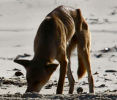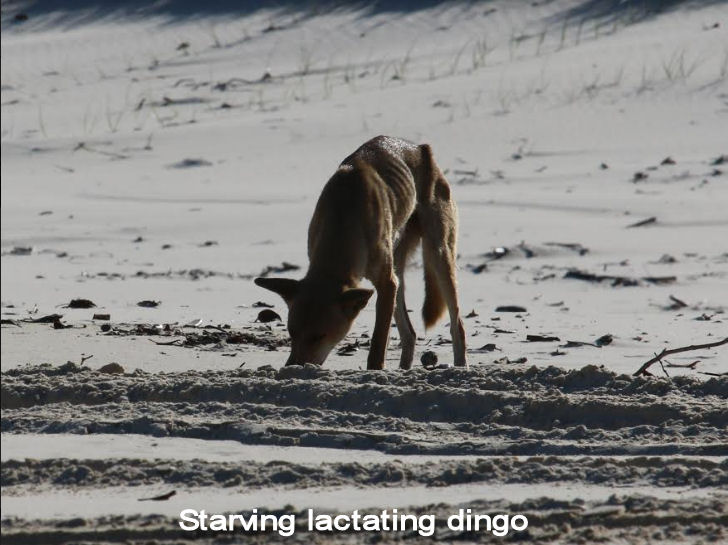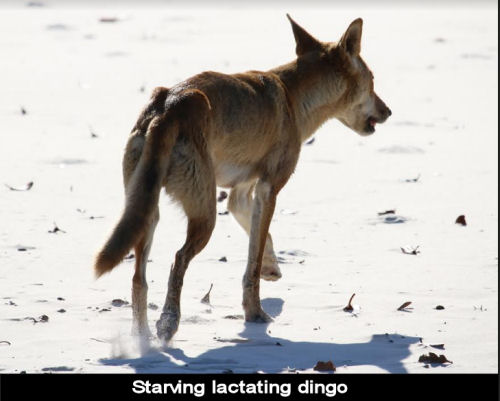Vet says, pictures prove Fraser Island dingoes are starving

 Dr John Kingston, Veterinary Advisor to Australia's National Dingo Preservation and Recovery Program, says that the internationally beloved dingoes of Fraser Island (K'Gari) have all but disappeared from their beach territories as government authorities condemn survivors to a cruel death by starvation.
Dr John Kingston, Veterinary Advisor to Australia's National Dingo Preservation and Recovery Program, says that the internationally beloved dingoes of Fraser Island (K'Gari) have all but disappeared from their beach territories as government authorities condemn survivors to a cruel death by starvation.
Dr Kingston said he was appalled at the condition of dingoes observed during recent NDPRP visits to the island.
‘Dingoes said by government and animal welfare authorities to be naturally lean are revealed as starving and probably doomed to extinction in photographs taken on the island for the NDPRP’, Dr Kingston said. ‘Hip bones protruding, backbone, ribs, muscle wastage, are all evidence that there is not enough food for these animals.
‘The Fraser Island dingoes are a semi-domesticate, an apex predator unique in the world, in that they form a bridge between the wild and humanity. Upwards of 80% of visitors to Fraser Island-K’gari wish to see a dingo in the wild. Is it any wonder, with seeing dingoes in this emaciated state that people want to feed them?
‘I don’t believe there is any veracity in the argument that feeding dingoes makes them aggressive. There is no scientific evidence for this at all. And yet it is an argument consistently raised and repeated by government authorities and their scientific advisors. This false belief was shown to be based on misinterpreted data in a paper by Rob Appleby, Bradley Smith et al, and another by Arian Wallach and Adam O’Neill. Prior to 1994 when the feeding of dingoes was stopped on Fraser Island, there had never been an attack by a dingo on a human.‘Therefore,’ Dr Kingston says, ‘it is imperative that feeding of these dingoes commences. There is also no data to prove government statements that the dingoes will overpopulate the Island if supplementarily fed, as dingoes self-regulate their own numbers. These imaginary problems never occurred during the thousands of years the dingoes were fed. We call for random food drops immediately.’
The Queensland Parks and Wildlife Service, which has legal responsibility for the animals’ welfare has consistently rejected conservationist concerns.
And the RSPCA, which once warned that the QPWS could be prosecuted for animal cruelty over its use of dingo traps on the island, now seems to back management policies, also referring to ‘skinny dingoes’ which it says are naturally lean and in good condition.

‘The photos show young females from the same territory, not old enough to reproduce and obviously not subject to pack support or discipline, now being pregnant, a sign of a species in crisis’, he said.
‘In a stable dingo pack, alpha females suppress breeding amongst other female pack members, so they are more able to help care for her pups and raise a successful litter.
‘Where are the animal ethics, and can we as a nation of animal lovers continue to watch as these animals slowly die a cruel death from starvation?
‘Do we wish for our overseas visitors to see the way we treat these precious iconic animals?
‘Where is Compassionate Conservation in all this?’
Dr John Kingston, BVSc,
Veterinary advisor
National Dingo Preservation and Recovery Program (Inc. A0051763G )(NDPRP)


Recent comments